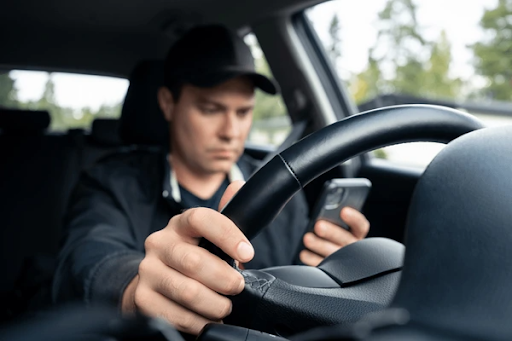Now Reading: How Distracted Driving Leads to Tragic Outcomes and What We Can Do About It
-
01
How Distracted Driving Leads to Tragic Outcomes and What We Can Do About It

How Distracted Driving Leads to Tragic Outcomes and What We Can Do About It
Distracted driving is a significant danger on our roads, often leading to tragic accidents and life-changing consequences. This article breaks down the different types of distractions—visual, manual, and cognitive—and stresses the importance of drivers staying focused behind the wheel.
It looks at common causes, such as texting, using a phone, and adjusting music, as well as severe outcomes, such as injuries and fatalities. It also covers practical ways to address the issue, such as community efforts and public service announcements, to encourage safer driving for all.
What is Distracted Driving?
Distracted driving happens whenever a driver’s attention is taken from the road, putting everyone’s safety at risk. The NHTSA points to visual, cognitive, and manual distractions as crucial factors in many car crashes, with activities like texting or checking social media being significant culprits.
The statistics are concerning, as drivers who engage in these behaviors are likelier to cause an accident. Understanding how distractions affect road safety is essential, and laws aimed at reducing distracted driving play a critical role in addressing this growing issue.
What are the Types of Distracted Driving?
Visual Distractions
Visual distractions, like checking a phone, looking at passengers, or glancing at roadside ads, take a driver’s attention off the road and significantly increase the risk of accidents. These seemingly brief moments of distraction can lead to severe consequences, with visual distractions accounting for nearly 30% of car crashes. Even glances at a playlist or a passing billboard can cause a driver to miss critical traffic changes, raising the chances of a collision.
Each year, over 390,000 injuries result from texting while driving, and in 2019 alone, 3,142 lives were lost due to distracted driving. This highlights the importance of staying focused behind the wheel and fostering a driving culture that prioritizes safety.
Manual Distractions
Manual distractions, like adjusting the radio, eating, or using a phone while driving, can create dangerous situations by taking a driver’s hands off the wheel. These shared behaviors have contributed to a significant rise in accidents, with around 390,000 injuries annually in the U.S. caused by such distractions.
Activities like reaching for food or manipulating a GPS may seem harmless but can severely impair a driver’s ability to react to traffic changes, increasing the risk of collisions. States like Virginia, Maryland, New Mexico, and Mississippi have introduced stricter laws to address these risks and promote safer driving habits.
Cognitive Distractions
Cognitive distractions, like daydreaming or engaging in conversations, can seriously impact a driver’s focus and lead to dangerous situations on the road. Studies show that over 60% of crashes are linked to cognitive distractions, where drivers are mentally preoccupied with unrelated thoughts, such as work issues.
Activities like talking to passengers or scrolling through social media, especially during stops, further increase the risk of accidents among teens. Staying mentally focused behind the wheel is critical, and awareness efforts, like Distracted Driving Awareness Month, stress the importance of driver education to improve road safety.
What are the Causes of Distracted Driving?
Distracted driving is caused by a range of everyday activities that many drivers engage in daily, often without realizing the risks. Cell phone use, particularly texting and browsing social media, is a significant contributor to accidents, with over 3,100 fatalities in 2019 alone. Other distractions like eating, drinking, adjusting music or GPS, and talking to passengers divert attention from the road, increasing the likelihood of crashes.
Studies show drivers texting or eating while driving are significantly more prone to accidents. To combat this, many states have enacted laws and launched campaigns like “It Can Wait” and “U Drive U Text U Pay” to raise awareness and encourage safer driving. Efforts to promote distraction-free driving through community involvement and public safety initiatives are critical in reducing the growing number of distracted driving incidents and saving lives.
What are the Consequences of Distracted Driving?
The impact of distracted driving is far-reaching, leading to thousands of preventable injuries and fatalities each year. Beyond the tragic loss of life, distracted driving causes significant property damage and imposes a heavy financial burden on individuals, families, and communities. Car accidents due to distracted driving account for a large portion of road fatalities, with smartphone use being a primary culprit.
Injuries from these crashes can leave survivors with lasting physical, emotional, and financial challenges, while families often face overwhelming grief and economic hardship. Property damage, medical expenses, and lost income add to the financial strain.
Services like 1-800-ASK-GARY can help connect accident victims to medical and legal resources, underscoring the urgent need for stricter distracted driving laws, stronger enforcement, and public awareness campaigns to reduce these risks and save lives.
How Can We Prevent Distracted Driving?
Preventing distracted driving requires a mix of education, strong laws, technology, and personal responsibility. Community programs and safety campaigns, like “It Can Wait,” help spread awareness, especially to younger drivers.
Laws and penalties are crucial, but public awareness and education are key to reinforcing safer habits. Technology, such as hands-free devices, apps that block notifications, and in-car systems that alert distracted drivers, can also help keep attention on the road.
Ultimately, personal responsibility is critical, with drivers committing to avoiding distractions like texting or adjusting navigation while driving, ensuring safer streets for everyone.










